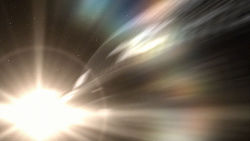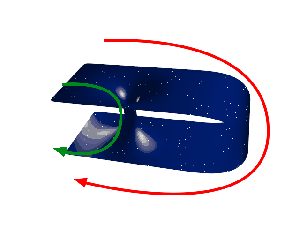| |||||
- For information on the Original Series' modes of propulsion, see Propulsion (TOS).
| An article from |
In the Re-imagined Series, propulsion is managed with the fuel tylium. Ships can travel at sublight speeds, or, when trying to escape (or chase) either vessels, they can employ apparent faster-than-light (or "FTL") engines.

Faster than Light Travel[edit]
FTL is a acronym for Faster-Than-Light. The term refers to a means of interstellar propulsion utilized by the Cylons and the Colonials. A common shorthand term for FTL travel is "jumping".
The FTL drive makes interstellar travel possible for both the Colonials and Cylons. No longer confined to their own home solar system, the Cylons managed to avoid Colonial interference for 40 years after the Cylon War and establish their own home-world. However, not all ships — from small to large — are outfitted with these drives (Miniseries).
It is likely that FTL drives are not commonplace on many civilian ships because of the costs involved in using and maintaining the drive and the amount of fuel available. For some civilian ships that travel comparatively short distances between some destinations, such as the ill-fated Botanical Cruiser, FTL may simply be impractical or unnecessary.
The technology behind FTL systems is such that, providing the relevant data is known, ships can jump with a high degree of accuracy, allowing ships to rendezvous in space and even "park" in a synchronous orbit directly above a given point on a planet's surface (Miniseries). Proper FTL use even enables vessels to arrive in crowded areas, such as the middle of an asteroid field or other ships, without the risk of collision and damage (The Hand of God).
No specific information on the technology of an FTL drive has been given in the Miniseries or regular series. We know only that Galactica has two FTL drives[1], and that other smaller or civilian ships have a single drive. We also know from dialogue that the FTL drives on Galactica are "spun up", suggesting the application of electromagnetic or rotational principles. Similarly it may be just a turn of phrase.
FTL jump drives can be used within an atmosphere. This Colonial tactic is used often to evade Cylon detection. While Raptors primarily perform these kind of jumps, Admiral William Adama performs a daring intra-atmosphere jump at approximately 100,000 feet altitude with Galactica during the Battle of New Caprica to evade immediate Cylon detection. The battlestar jumps back to space a few hundred feet above the planet's surface after its Viper deployment. When Galactica jumps, the clouds surrounding it and the re-entry fires consuming its hull are "sucked" into the vacuum created by the sudden loss of mass. A sonic boom is also heard afterward (Exodus, Part II).
Colonial Limitations[edit]
- Colonial FTL systems are not small-scale, and cannot be installed into vehicles such as the Viper. They can, however, be used on vehicles the size of a Raptor, which is limited to brief, short-distance jumps. Raptors can make a sequence of short FTL "hops" in a row, to reach the same destination as a capital ship with a full-sized FTL drive (Miniseries).
- Colonial FTL systems cannot be used multiple times over a long period of time, for they are prone to breakdown after excessive, repetitive use (33).
- FTL jumps can apparently induce nausea or discomfort in some people, such as Cally (Miniseries, "Kobol's Last Gleaming, Part I").
- When "jumping" the Colonial drive systems are limited in size; this defines the maximum size to which a colonial vessel can be built (hence the need for certain battlestars to retract their landing pods and reduce their overall cross-section prior to a jump (Miniseries, "33", etc.).
- Colonial FTL systems appear to be a holdover from the Exodus from Kobol, and their current designs have been developed to meet the needs of jumping between the Twelve Colonies, and their outposts in other star systems. Colonial FTL capabilities have defined limits, referred to as the Red Line, beyond which jumps may not be possible / could result in damage to a vessel's drive system / lead to navigational inaccuracies that might put the ship at risk.
- Navigators must be careful to plan FTL jump paths in order to keep a safe distance from planets or other large objects (Kobol's Last Gleaming, Part I).
Knowing the limitations of their own FTL drives, a team apparently led by Lieutenant Felix Gaeta successfully refitted a Raptor with the navigational computer from a captured Heavy Raider (presumably the one used by Kara Thrace to return from Caprica in "Home, Part I"). They later use its improved jump plots (with the aid of the cooperative copy of Sharon Valerii) to coordinate a squadron of Raptors to fly back to Caprica for a rescue mission to retrieve a team of resistance fighters there (Lay Down Your Burdens, Part I). Despite the accuracy of the advanced Cylon FTL technology and Valerii's aid in marking the jumps, three Raptors do not complete the mission. One obtains corrupted jump data and finds itself within a nebula and a undiscovered habitable planet, and is forced to return to the Fleet. The other Raptors also get corrupted coordinates and materializes inside a nearby mountain on the final intra-atmosphere jump to Caprica, with the loss of ship and crew.
Cylon Advantages in FTL[edit]
- Cylon FTL systems can be manufactured on a smaller scale to their Colonial equivalent, thus allowing the Cylon Raider to be outfitted with an FTL drive. (Miniseries).
- Cylon FTL drive systems are far more efficient than their Colonial equivalent. Tests with the Raider captured by the Battlestar Galactica (You Can't Go Home Again) demonstrated that the drive could enable the Raider to jump directly from the vicinity of Kobol back to Caprica (Kobol's Last Gleaming, Part I) - a jump completed by Lieutenant Kara Thrace during her search for the Arrow of Apollo (Kobol's Last Gleaming, Part II).
- That superiority however does not stem directly from the FTL drives, but mainly from the superior Cylon navigation system, resulting in more accurate jump calculations. Colonial vessels interfaced with a Cylon computer can increase their jump range by a factor greater than ten (Lay Down Your Burdens, Part I).
Given that the Cylons left Colonial space to find their own planet, it is possible that their longer-range FTL capability was created in response to a desire to be able to cover the distance between their homeworld and those of the Twelve Colonies with a single jump.
The Cylons may also be capable of faster-than-light communication.
Background to FTL in the Re-imagined Series[edit]
In establishing the series the creators of the new Battlestar Galactica determined to keep everything within the show very "natural". This means steering away from the standard clichés of television science-fiction: no bumpy-head aliens, no remarkable technology such as matter/anti-matter conversion, etc. So how is the concept of faster-than-light travel possible within this precept?
Underpinning Theories[edit]

The FTL drive technology used within the Re-imagined Series appears to be based on the use of Superstring Theory and M-Theory that essentially enable the "jump drive" systems to "fold" space, reducing the distance between any two points by creating a "corridor" through space that links them together (essentially forming a wormhole, or Einstein-Rosen Bridge). Such "corridors" are allowed by the general theory of relativity; what M-Theory does is provide a way to change the topology of space-time dynamically.
The use of such Wormholes is based on the tenet that space is curved. Hence the term "wormhole", which arises from the analogy that space can be seen as an apple. A worm can travel from one side of the apple to the other in two ways:
- By crawling over the surface, or
- By burrowing through the apple (creating a "wormhole").
Obviously, the second option is considerably shorter than the first.
Relativistic Acceleration[edit]
A key point concerning the use of wormholes within the new Battlestar Galactica is that they do not break the fundamental limiting factor of our universe: the speed of light. Vessels in Battlestar Galactica do not accelerate to faster-than-light velocities. Rather, they use the wormhole to reduce the distance to their destination, thus giving the impression of faster-than-light travel.
However, the FTL jumps in the series do allow information to be sent faster than light can send it, which results in a violation of causality within the special theory of relativity. (ie. If event A comes before B from one viewpoint, there will be other equally valid viewpoints where event B takes place before A.) Causality is not violated by FTL in a universe that has a special fixed reference frame, however this contradicts current understanding.
This is the reason why FTL jumps are virtually instantaneous within episodes. It also means that the only direct form of propulsion available for vessels is generated by their sublight drive systems[2].
Feasibility[edit]
While the use of wormholes in this manner is not currently possible, work is progressing on superstring and M-Theory which may make the creation of wormholes possible in the future. The limiting factor is the ability to generate negative energy densities, which are allowed (though severely restricted) by quantum mechanics. As such, the use of such systems again meets one of the stated desires of the the producers of the new Battlestar Galactica: not to rely on the "traditional" trappings of science-fiction that require exotic science and technology. Theoretical physicist Kip Thorne has carried out extensive research into wormholes, and helped develop a scientifically-consistent means of wormhole travel used by Carl Sagan in his novel "Contact" which bears a remarkable similarity to the technology employed within Battlestar Galactica.
Sublight propulsion[edit]
In the Re-imagined Series, all ships have some manner of sublight flight ability. Sublight propulsion is convenient for intra-solar system travel (such as to or from the planets that comprise the Twelve Colonies), but cannot be used for travel outside of a solar system as the time to arrive at a destination may exceed the fuel supply of the ship or the lifetime of the crew that fly the ship.
Many of the ships of the Fleet are capable of landing on and taking off from planets, such as New Caprica. Galactica is never seen doing this, and its large mass might prohibit planetary landings altogether, but it employs sublight engines for normal spaceflight. Few of the ships appear to have extremely large propellant tanks as would be required for rocketry as it is presently understood, in spite of having aft-mounted thrusters. However, this might be explained by the properties of the tylium fuel. Especially smaller vessels employ rocketry-based RCS thrusters for small course adjustments.
Vipers are equipped with a thrust reversal system to counteract or arrest their forward momentum (The Hand of God). No such mechanism exists on capital ships, but such vessels might turn by 180° to decelerate.
Cylons baseships don't have any nozzles or show any external sources for their propulsion ability. It is possible that force fields of the artificial gravity generators are be the source of the sublight propulsion.
Both Colonial and Cylon missiles used in combat appear to be rockets, leaving a trail of gas behind them.
The law of conservation of momentum requires that any propulsion system which adds momentum to a spacecraft or missile involves an equal amount of momentum be imparted in the opposite direction to something else, such as a reaction mass like rocket fuel, or possibly large masses like planets through use of a force field.
See Also[edit]
References[edit]
- ↑ Dialogue from Colonel Tigh to Lt. Gaeta instructs the tactical officer to "spin up FTL drives 1 and 2" in the Miniseries.
- ↑ In turn, this is why vessels exiting from a jump are traveling at the same velocity as when they committed to the jump (Miniseries, "33," "The Hand of God," and other episodes).
External links[edit]
- FTL at Wikipedia.

